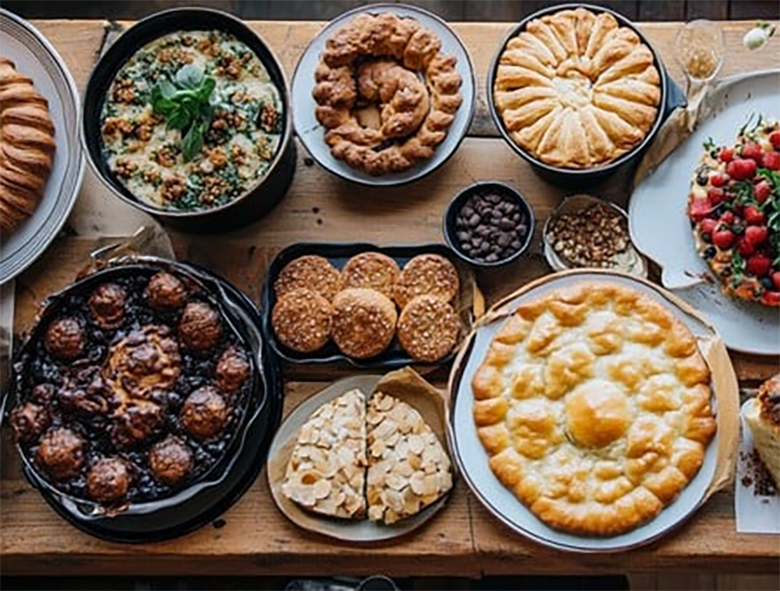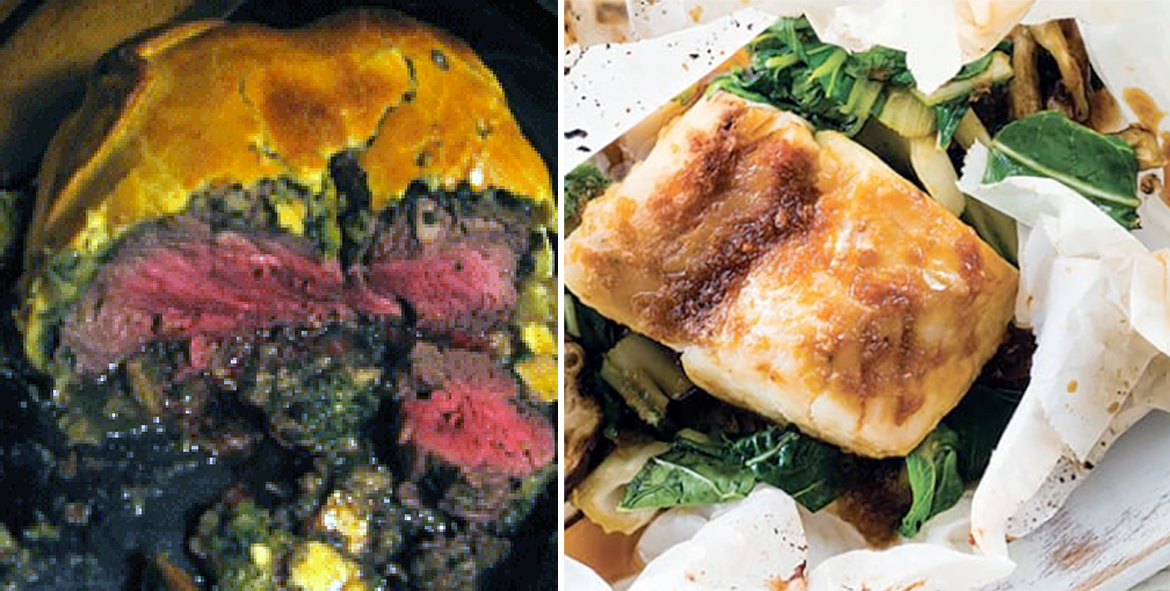FabulousFusionFood's Baking Recipes 25th Page
 A range of baked goods.
A range of baked goods.
Welcome to FabulousFusionFood's Baking Recipes Page — This is a continuation of an entire series of pages that will, I hope, allow my visitors to better navigate this site. As well as displaying recipes by name, country and region of origin I am now planning a whole series of pages where recipes can be located by meal type and main ingredient. This page gives a listing of all the baking recipes added to this site. Baking is defined as a technique for the prolonged cooking of food using dry heat by the action of conduction. Baking is normally done in an oven, but goods may also be baked in hot ashes or on hot stones. Baking differs from Roasting Recipes in that a lower temperature is typically used and the items are cooked for a longer period of time. Baking is a much older process than most people think and foods were probably originally baked in embers or with hot stones (which is how bread may have started). Only later did specialist ovens develop. Though most baked goods tend to be bread or cake-based some other dishes such as pasta dishes and vegetable dishes may also be baked. Stews are often also technically baked in an oven, but are not classed as 'baked goods' in that they are more liquid than solid at the end of the cooking process.
Baking is a method of preparing food that uses dry heat, typically in an oven, but can also be done in hot ashes, or on hot stones. The most common baked item is bread, but many other types of foods can be baked. Heat is gradually transferred "from the surface of cakes, biscuits and cookies, and pieces of bread to their centre, typically conducted at elevated temperatures surpassing 150°C. Dry heat cooking imparts a distinctive richness to foods through the processes of caramelization and surface browning. As heat travels through, it transforms batters and doughs into baked goods and more with a firm dry crust and a softer centre. Baking can be combined with grilling to produce a hybrid barbecue variant by using both methods simultaneously, or one after the other. Baking is related to barbecuing because the concept of the masonry oven is similar to that of a smoke pit.
In addition to bread, baking is used to prepare cakes, pastries, pies, tarts, quiches, biscuits and cookies, scones, crackers, pretzels, and more. These popular items are known collectively as 'baked goods', and are often sold at a bakery, which is a store that carries only baked goods, or at markets, grocery stores, farmers markets or through other venues.
 Beef en croûte (left) and fish en papillote (right).
Beef en croûte (left) and fish en papillote (right).
The alphabetical list of all the baking recipes on this site follows, (limited to 100 recipes per page). There are 2545 recipes in total:
Page 25 of 26
| Tourte bretonne (Breton pie) Origin: France | Tropical Chicken Pizza Origin: American | Vanilla Pudding Mix Origin: American |
| Tourteletes in fryture (Honey-basted Fig Pastries) Origin: England | Tsoureki (Greek Easter Bread) Origin: Greece | Vanilla Shortbread Origin: Britain |
| Tourtes parmeriennes (Parmesan Pies) Origin: France | Tunu Ahi Ika Origin: Easter Island | Vanilla Thins Origin: Britain |
| Tourtière Origin: Canada | Turkey and Cranberry Mini Pies Origin: Britain | Vanilla Wafers Origin: American |
| Towering Praline Carrot Cake Origin: American | Turkey Curry Samosas Origin: Britain | Vanille Kranse (Vanilla Rings) Origin: Denmark |
| Tractae (Pastry Sheets) Origin: Roman | Turkey Tetrazzini Casserole Origin: American | Vasilopita (Greek New Year Bread) Origin: Greece |
| Traditional Air Fryer Scones Origin: Britain | Turnip Pasty Origin: England | Vastlakuklid (Estonian Lenten Buns) Origin: Estonia |
| Traditional Black Bun Origin: Scotland | Turnip Puff Origin: American | Vegan Gluten-free Christmas Cake Origin: Britain |
| Traditional Bread and Butter Pudding Origin: Britain | Tuscan Ricotta Cheesecake Origin: American | Vegetarian Haggis Origin: Scotland |
| Traditional Bread Dough Pizza Base Origin: Italy | Tuvaluan Coconut Bread Origin: Tuvalu | Vegetarian Pot Roast Origin: Britain |
| Traditional Cornbread Origin: America | Tvarahovy Kolác Treny (Czech Cheesecake) Origin: Czech | Veldt Bread Origin: Namibia |
| Traditional Cornish Pasty Origin: Cornwall | Twelfth-night Cake Origin: Britain | Venison Bredie Origin: Scotland |
| Traditional Fruit Cake Origin: Britain | Twenty-five Centimetre Pumpkin Pie Origin: American | Venyson Y-bake (Medieval Venison Pie) Origin: England |
| Traditional Historic Bobotie Origin: South Africa | Two-crust Apple Pie Origin: American | Vermont Maple Spice Cupcakes Origin: American |
| Traditional Mince Pies Origin: British | Tyropatinam (Baked Custard) Origin: Roman | Very Berry Cupcakes Origin: Britain |
| Traditional Pork Pie Origin: Britain | Tyttebœr Brød (Lingonberry Bread) Origin: Denmark | Very Rich Chocolate Fudge Cake Origin: American |
| Traditional Pumpkin Pie Origin: British | Ube Cheesecake Origin: Austria | Victoria Sandwich Cake Origin: British |
| Traditional Sachertorte Origin: Austria | Ukaeb (Minced Crab with Coconut Cream) Origin: Palau | Victoria Sponge Origin: England |
| Traditional Scottish Gingerbread Origin: Scotland | Ukrainian Sour Cream Pastry Origin: Ukraine | Victorian Dundee Cake Origin: England |
| Traditional Vegetable Bake Origin: Ireland | Ulu (Hawaiian Roasted Breadfruit) Origin: Hawaii | Virgin Islands Coconut Tart Origin: US Virgin Islands |
| Traou Mad (Breton Macaroons) Origin: France | Um Ali (Puff Pastry Milk Pudding) Origin: Kuwait | Vitumba (Rice Cupcakes) Origin: Tanzania |
| Traybake Keralan Fish Curry Origin: Fusion | Umm Ali (Puff Pastry Milk Pudding) Origin: Qatar | Walnut Clusters Origin: Britain |
| Treacle Raisin Gingerbread Origin: Britain | Uru (Roasted Breadfruit) Origin: Society Islands | Walnut Shortbread Origin: Britain |
| Treacle Scones Origin: Britain | Vínarterta (Icelandic Layer Cake) Origin: Iceland | Warka Dough Origin: Morocco |
| Trencher Origin: England | Valentine Cupcakes Origin: Britain | Warm Chocolate Pie Origin: Anguilla |
| Tres Leches Cake Origin: Chile | Valentine Raspberry Scones Origin: Cornwall | West Indian Cake Origin: British |
| Trini Coconut Sweet Bread Origin: Trinidad | Valentine's Day Chocolate Cheesecake Origin: American | Wet Nelly Origin: England |
| Trini Curried Shrimp Patty Origin: Trinidad | Vanilla Cake Mix Cake Origin: American | Wet Nelly II Origin: England |
| Trini Meat Patties Origin: Trinidad | Vanilla Cake Mix Chocolate Cake Origin: American | Wheaten Bread Origin: Northern Ireland |
| Trini Milk Cake Origin: Trinidad | Vanilla Cake Mix Lemon Cake Origin: American | Wheaten Meal Scones Origin: Scotland |
| Trinidad Hops Bread Origin: Trinidad | Vanilla Cake Mix Spice Cake Origin: American | White Bread Mix Origin: Suriname |
| Trinidadian Black Cake Origin: Trinidad | Vanilla Cheesecake Origin: American | White Lemon Cake Mix Cake Origin: American |
| Triopita (Greek Cheese Pie) Origin: Greece | Vanilla Chocolate Cake Origin: Britain | |
| Tripolita (Greek Feta Pie) Origin: Syria | Vanilla Pastry Origin: Britain |
Page 25 of 26